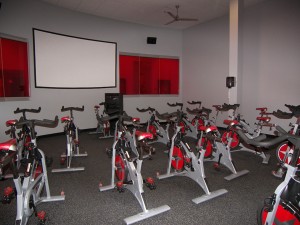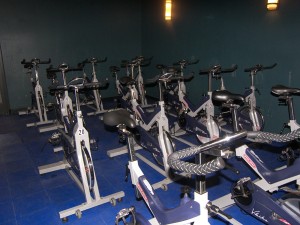
“As fitness trends come and go, indoor cycling is here to stay,” said Amanda Soerhide, the district athletic director for Mountainside Fitness. “For two decades indoor cycling has remained in the top five most popular group fitness formats. Indoor cycling combats the top drop-out excuses in regard to membership retention. It is affordable, easy to learn and is entertaining, and provides results without excessive time management required.”
Unlike other Group X classes, finding instructors for indoor cycling can be fairly simple due to its great popularity. However, a good point made by Adrienne McBride, the senior VP of programming for Club One, is to never stop searching for great instructors. “Look within your students,” she suggested. “You never know where your next great indoor cycle teacher is riding.”
Club operators and programmers in particular must continually be aware of the consistency of cycling instructors. Colin Irving, the CEO of RealRyder® International, said the biggest concern he has received from clubs is the amount of inconsistency members experience from instructors, from club to club or region to region. “Club operators need to understand the critical role their trainers/instructors will play in determining just how enjoyable the members experience will be, and how successful the program will be at generating results. Even the best equipment can sit idle, be used inconsistently, or worse — used dangerously — if the instructors aren’t properly educated.”
Many issues found in indoor cycling can quickly be disparaged due to the consistent lifespan of indoor cycling as a major fitness class. “Continuous industry research has governed methods and movements that are safe and effective,” explained Soerhide. “Like other fitness formats, certain maneuvers may at first seem appropriate, but later prove to be risky. The responsibilities to be aware of such contradictions require frequent updates and communication between management and staff.”
Operators with multiple locations should find a way to instruct trainers at each location to perform classes with a certain level of consistency, with safety of the members in mind. However, indoor cycling classes have long been famous for the personalities of the instructors, creating a cult following at certain locations.
“Regular evaluations keep instructors focused on policies and industry updates,” said Soerhide. “Instructors must also frequently refresh music selection and terrain choreography. The IMAX experience is also an impressive method to keep members engaged, but with respect to changing videos frequently.”
“Getting current members to try group cycling classes is an easy sell,” said Soerhide. “Beyond social media sites such as LinkedIn, or Branch Out, most national certification organizations have network registries. Facilities can contact such organizations for a listing of instructors in their area. Such organizations include, but are not limited to ACE, AFAA, Madd Dogg Athletics, Reaction Cycling and Keiser.”

“Another great way to promote indoor cycling, to attract new members, is to engage them in events such as a group FTP (functional threshold power) ride, an indoor triathlon or a ride benefiting a local charity or organization,” said Laurel Mylin, the general manager of Stages Indoor Cycling. “Promoted group rides are a great way to develop your facility’s team atmosphere and get newer members involved, as there is a tremendous social aspect to an intense group ride, or a group riding for a collective purpose.”
“Simply implementing a cardio training variety calendar will make a tremendous impact,” explained Cameron Chinatti, the director of education for Stages Indoor Cycling. “This will lead to rock-solid programming that can easily withstand inevitable instructor changes and employee turnover. Riders will quickly realize that there are more ‘flavors’ of indoor cycling than simply ‘chest-burning cardio.’ When they start to diversify their rides and develop both low-end and high-end endurance, they are more likely to see results.”
“Indoor cycle classes are an activity that can be enjoyed by everyone,” said McBride. “Because participants are riding individual bikes, they are able to ride at their own intensity level within the class. This makes it possible for both beginners and expert cyclists to ride together.”
Further advancements in indoor cycling have included the use of heart rate monitors that allow riders to monitor their heart rate and calorie burn throughout the ride. At Club One, the digital display on the cycle “shows the rider’s real time stats like exact resistance level and RPM’s,” explained McBride. “Bikes can even be wired to a large digital screen in front of the classroom where they can compete with classmates.”
“The American Heart Association suggests that adults 18-65 exercise a minimum of 30 minutes, three times per week,” explained Soerhide. “Indoor cycling provides consistent calories burned, and also increases the body’s production of pain-killing endorphins. Participants who enjoy group cycling classes more than other formats, state that it is in part due to the fact that coordination and detailed concentration is not required. Participants are allowed to release their minds and be guided through a virtual tour, which proves to be excellent for stress management.”
Although indoor cycling can’t give members the exact sensation of cycling through the mountains or down the coast of California, it does provide members with practice for an activity they enjoy, or strictly a way to have fun exercising with a group. The variations in indoor cycling can be completely up to you, your members and your instructors. How has indoor cycling altered your member experience, and what “spins” have you given to the class to keep it fresh for members at all experience levels?
By Tyler Montgomery









